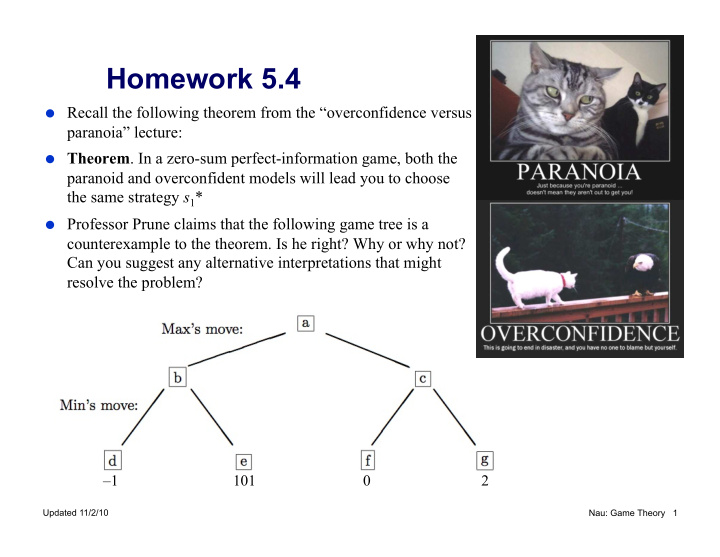



Homework 5.4 Recall the following theorem from the “overconfidence versus paranoia” lecture: Theorem . In a zero-sum perfect-information game, both the paranoid and overconfident models will lead you to choose the same strategy s 1 * Professor Prune claims that the following game tree is a counterexample to the theorem. Is he right? Why or why not? Can you suggest any alternative interpretations that might resolve the problem? –1 101 0 2 Updated 11/2/10 Nau: Game Theory 1
Homework 6.1 In repeated games, which of the following strategies are stationary? AllC : always cooperate AllD (the Hawk strategy): always defect Grim : cooperate until the other agent defects, then defect forever Tit-for-Tat (TFT) : cooperate on the first move. On the n th move, repeat the other agent ( n –1) th move Random : Randomly intersperse cooperation and defection Tester : defect on move 1. If the other agent retaliates, play TFT. Otherwise, randomly intersperse cooperation and defection Tit-For-Two-Tats (TFTT) : Like Tit-for-Tat, except that it retaliates only if the other agent defects twice in a row Generous Tit-For-Tat (GTFT) : Like Tit-for-Tat, but with a small probability c >0 of cooperation on the n ’th move if the other agent defected on the ( n –1) th move Pavlov (Win-Stay, Lose-Shift) : Repeats its previous move if it earns 3 or 5 points in the previous iteration, and reverses its previous move if it earns 0 or 1 points in the previous iteration Updated 11/2/10 Nau: Game Theory 2
Homework 6.2 Recall that DBS’s opponent model is as follows: A set of rules of the following form if our last move was m and their last move was m' then P [their next move will be C ] • Four rules: one for each of (C,C), (C,D), (D,C), and (D,D) For example, TFT can be described as • (C,C) ⇒ 1, (C, D) ⇒ 1, (D, C ) ⇒ 0, (D, D) ⇒ 0 (a) Which of the strategies in Homework 6.1 can be represented by DBS’s opponent model? (b) Are there any stationary strategies that DBS’s opponent model cannot represent? Why or why not? (b) Are there any stationary strategies that DBS’s opponent model cannot represent? Why or why not? Updated 11/2/10 Nau: Game Theory 3
Homework 6.3 Let S be the following set of interaction traces for the iterated battle of the sexes with 6 iterations. (a) What are the compatible subsets of S ? (b) For each compatible subset, what is the composite trace and its expected utility if we assume agents a 2 , a 4 , a 6 , and a 8 are equally likely? Trace 1 Trace 2 Trace 4 Trace 3 a 1 a 2 a 3 a 4 a 5 a 6 a 7 a 8 G T G T T G T G G T G T T G T T G G T G T T T G T T G G T G G T T G T G G T G T T G G T G G T T Updated 11/2/10 Nau: Game Theory 4
Homework 6.4 (a) What is the expectiminimax value of the following game tree? MAX 3 − 1 CHANCE 0.5 0.5 0.5 0.5 1/4 3/4 1/3 2/3 2 4 0 − 2 MIN 2 4 7 4 6 0 5 − 2 2 4 6 8 10 –2 –4 –6 Updated 11/2/10 Nau: Game Theory 5
Homework 6.5 (b) Do we need to know z in order to know the expectiminimax value of the game tree? Why or why not? MAX 3 − 1 CHANCE 0.5 0.5 0.5 0.5 1/4 3/4 1/3 2/3 2 4 0 − 2 MIN 2 4 7 4 6 0 5 − 2 2 4 6 8 10 –2 –4 z Updated 11/2/10 Nau: Game Theory 6
Homework 6.5 (c) Do we need to know y and z in order to know the expectiminimax value of the game tree? Why or why not? MAX 3 − 1 CHANCE 0.5 0.5 0.5 0.5 1/4 3/4 1/3 2/3 2 4 0 − 2 MIN 2 4 7 4 6 0 5 − 2 2 4 6 8 10 –2 y z Updated 11/2/10 Nau: Game Theory 7
Homework 6.5 (d) Suppose we know in advance that every terminal node has a value in the range [–10, +10]. For what values of x (if any) will y and z have no effect on the expectiminimax value of the tree? MAX 3 − 1 CHANCE 0.5 0.5 0.5 0.5 1/4 3/4 1/3 2/3 2 4 0 − 2 MIN 2 4 6 8 10 x y z 2 4 7 4 6 0 5 − 2 Updated 11/2/10 Nau: Game Theory 8
Homework 6.6 Consider the double lottery game with the imitate-the-better dynamic. Suppose agent a ’s strategy is R and agent b ’s strategy is RwS . If we compare the two agents’ payoffs in order to decide which of them reproduces, then what are their probabilities of reproducing? Updated 11/2/10 Nau: Game Theory 9
Recommend
More recommend